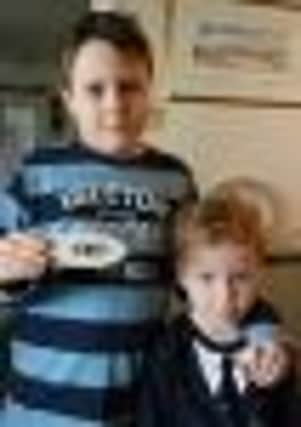Tagged cuttlefish ends up 200 miles away – at Rustington


But for a family in Rustington, a brisk walk along the village’s shoreline could play a part in helping scientists unravel the mystery behind one of the English Channel’s most common – yet secretive – sea creatures.
When Swedish-born brothers Alexander and Erik Johnson discovered a peculiar-looking cuttlefish washed up on the beach, the youngsters ran straight back to tell their grandfather, Sidney Johnson, at his home in Chanctonbury Road.
Advertisement
Hide AdAdvertisement
Hide AdAlexander, nine, and Erik, four, had been staying with their grandfather for the past week, with their mother and father, and were only days away from returning home to Kungälv, Sweden, when they discovered the cuttlefish.
Little did the brothers know that the cuttlefish carcass had been tagged with an electronic monitoring device by marine biologists – almost 200 miles away.
An intrigued Alexander said: “I found it on the beach and wanted to turn it over because I thought it was a rock.
“I had no idea what the thing attached to it was. So I just asked dad, to see if he knew. I was very interested to know what it was.”
Advertisement
Hide AdAdvertisement
Hide AdOn further inspection, the youngsters’ father, Tony, 51, discovered a telephone number attached to the device.
Retired Metropolitan Police officer Sidney, 82, whose wife is currently in hospital in Guildford, said: “I had never seen anything like this before. You get to see plenty of cuttlefish washed up on the beach, but none like this.”
After calling the number, the family were put through to a representative from the Marine Biological Association UK (MBA), based in Devon, who passed them on to senior research fellow, Professor David Sims.
In a bizarre twist of fate, Prof Sims was, in fact, born at Rustington’s Zachary Merton Hospital, and knew the nearby beach well, having played and walked there countless times while growing up in Worthing.
Advertisement
Hide AdAdvertisement
Hide AdHe said: “I was shocked when I had a phone call saying that one of my cuttlefish had washed up on Rustington beach. I knew that stretch of coastline very well.”
Prof Sims explained that this particular cuttlefish had been one of only eight tagged in the sea off the coast of Torbay, Devon, in May last year, as part of an on-going experiment by the MBA to discover the winter migration habits of cuttlefish and that the data storage device, attached to the cuttlefish, was essential in unveiling the cephalopod’s, little-known habits.
Prof Sims, who studied at St Andrew’s CofE High School, in Worthing, during the 1980s, said: “We can gain so much valuable information from this form of research. It’s like a message in a bottle. From analysing the algorithms we can discover the temperature in the water, the distance and the direction that these cuttlefish travel.This is a method by which we can gain valuable information about these very secretive, creatures. We know virtually nothing about them.
“Hopefully, this method of tagging can reveal more about their spawning habits and migration routes during the winter period.
Advertisement
Hide AdAdvertisement
Hide AdHe added: “It’s particularly amazing that the tag was washed up in Rustington, as it was originally placed on that particular cuttlefish in Torbay, just under 200 miles away.
“However, we don’t think that the cuttlefish travelled from Torbay to Rustington, We think that it has probably died by natural means, somewhere between these two points, and has drifted from west to east, ending up on Rustington beach.”
The cuttlefish is the fourth to have been returned from the original eight that were tagged, and had travelled the furthest.
The other three were discovered in the sea off Torbay and Exmouth.
Advertisement
Hide AdAdvertisement
Hide AdSimilar research methods have been uses to analyse the migration movements of sharks and other marine life. Some of the animals tagged with this method have been know to turn up on beaches as far afield as Belgium.
Prof Sims said that the MBA offered a reward of £25 to anyone who discovered a tag still attached to the cuttlebone. However, if the tag had the flesh of the cuttlefish still attached, then the reward was increased to £50.
“We can extract a lot more data from cuttlefish with their flesh still attached, than just the cuttlebone,” he said.
“So when members of the public find these tags, it’s vital that they send them back to us, to analyse the data, hidden within.”
Alexander and Erik were given £25 for their tagged cuttlefish and agreed to donate it to Chestnut Tree House children’s hospice before flying home on Friday (January 20).